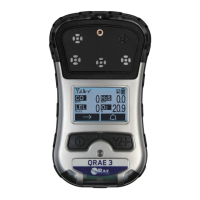33
18. When the upload is done, exit ProRAE Studio II.
19. Press [MODE] on the QRAE 3 to exit Communication Mode.
10. Calibration And Testing
10.1. Manual Alarms Test
Under Normal Operation Mode and non-alarm conditions, the buzzer (audible alarm),
vibration, visible alarms, and backlight can all be tested anytime by pressing [Y/+]. If any
alarm does not respond, check the alarm settings in the Programming Menu to make sure
all alarms are enabled (selected setting under Programming/Alarms/Alarm Settings
should be “All Enabled”). If any alarms are enabled but not functional, the instrument
should not be used.
10.2. Bump Testing And Calibration
RAE Systems recommends that a bump test be conducted periodically on the QRAE 3. The
purpose of a bump test is to ensure that the instrument’s sensors respond to gas and all the alarms
are enabled and functional.
The QRAE 3 multi-gas detector must be calibrated if it does not pass a bump test, or at
least once every 180 days, depending on use and sensor exposure to poisons and
contaminants.
Calibration intervals and bump test procedures may vary due to national legislation.
A bump test can be performed either manually or using the AutoRAE 2 Automatic Test and
Calibration System. When a bump test is done manually, the instrument makes a pass/fail
decision based on sensor performance, but the user still has the responsibility to make sure all the
alarms are enabled and functional.
Note: Bump testing and calibration can be performed using an AutoRAE 2 Automatic Test &
Calibration System. An AutoRAE 2 bump test takes care of both the sensor and alarm tests.
Consult the AutoRAE 2 User’s guide for details.

